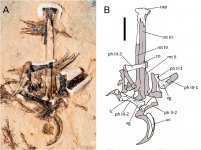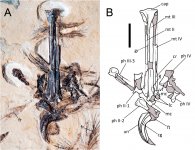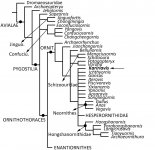Fred Ruhe
Well-known member

Ismar de Souza Carvalho, Federico L. Agnolin, Sebastián Rozadilla, Fernando E. Novas, José A. Ferreira Gomes Andrade & José Xavier-Neto, 2021
A new ornithuromorph bird from the Lower Cretaceous of South America
Journal of Vertebrate Paleontology. Online edition: e1988623. doi:10.1080/02724634.2021.1988623
Abstract: https://www.tandfonline.com/doi/abs/10.1080/02724634.2021.1988623?journalCode=ujvp20
The fossil record of Early Cretaceous birds in South America has been restricted to members of Enantiornithes from the Crato Formation (Aptian) of Brazil. Here we describe a new genus and species of bird discovered at Pedra Branca Mine, Nova Olinda County, Ceará State, Brazil, which adds to the avian fossil record from the Crato Formation. The specimen is represented by an isolated foot that is exposed in plantar view. A plantarly displaced metatarsal III with a well-developed hypotarsus supports its referral to Ornithuromorpha, representing the oldest member of the clade reported for Gondwana. Its unique foot conformation indicates that it may belong to an unknown ornithuromorph clade with some cursory similarities to extant flightless ratites. The presence of Early Cretaceous ornithuromorphs in Brazil indicates that the clade was widespread in Gondwana during the Mesozoic.
http://zoobank.org/urn:lsid:zoobank.org:pub:08333BA3-F231-4E61-9E89-105C7478AE31
The species described is: Kaririavis mater gen. et sp. nov.
Enjoy,
Fred
A new ornithuromorph bird from the Lower Cretaceous of South America
Journal of Vertebrate Paleontology. Online edition: e1988623. doi:10.1080/02724634.2021.1988623
Abstract: https://www.tandfonline.com/doi/abs/10.1080/02724634.2021.1988623?journalCode=ujvp20
The fossil record of Early Cretaceous birds in South America has been restricted to members of Enantiornithes from the Crato Formation (Aptian) of Brazil. Here we describe a new genus and species of bird discovered at Pedra Branca Mine, Nova Olinda County, Ceará State, Brazil, which adds to the avian fossil record from the Crato Formation. The specimen is represented by an isolated foot that is exposed in plantar view. A plantarly displaced metatarsal III with a well-developed hypotarsus supports its referral to Ornithuromorpha, representing the oldest member of the clade reported for Gondwana. Its unique foot conformation indicates that it may belong to an unknown ornithuromorph clade with some cursory similarities to extant flightless ratites. The presence of Early Cretaceous ornithuromorphs in Brazil indicates that the clade was widespread in Gondwana during the Mesozoic.
http://zoobank.org/urn:lsid:zoobank.org:pub:08333BA3-F231-4E61-9E89-105C7478AE31
The species described is: Kaririavis mater gen. et sp. nov.
Enjoy,
Fred
Last edited:






